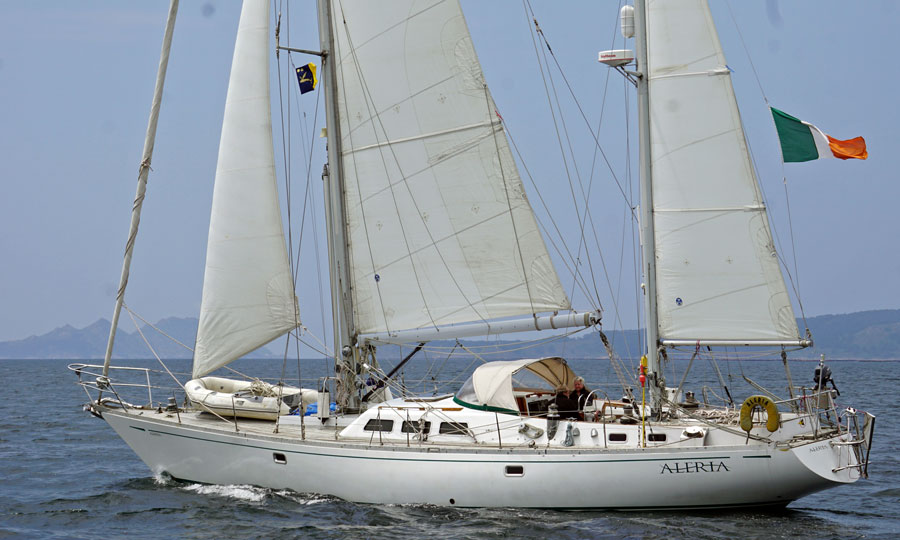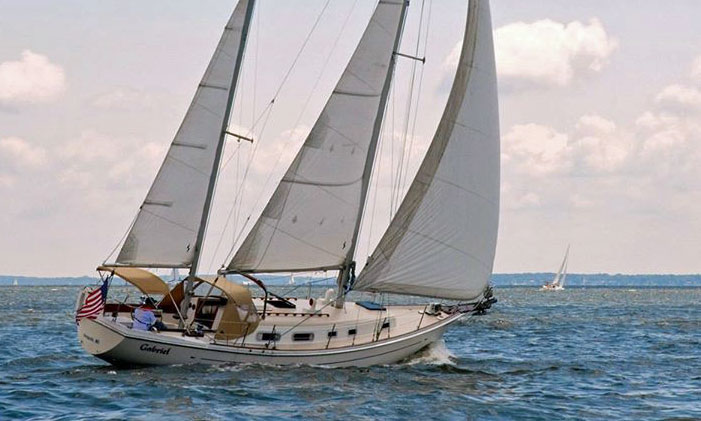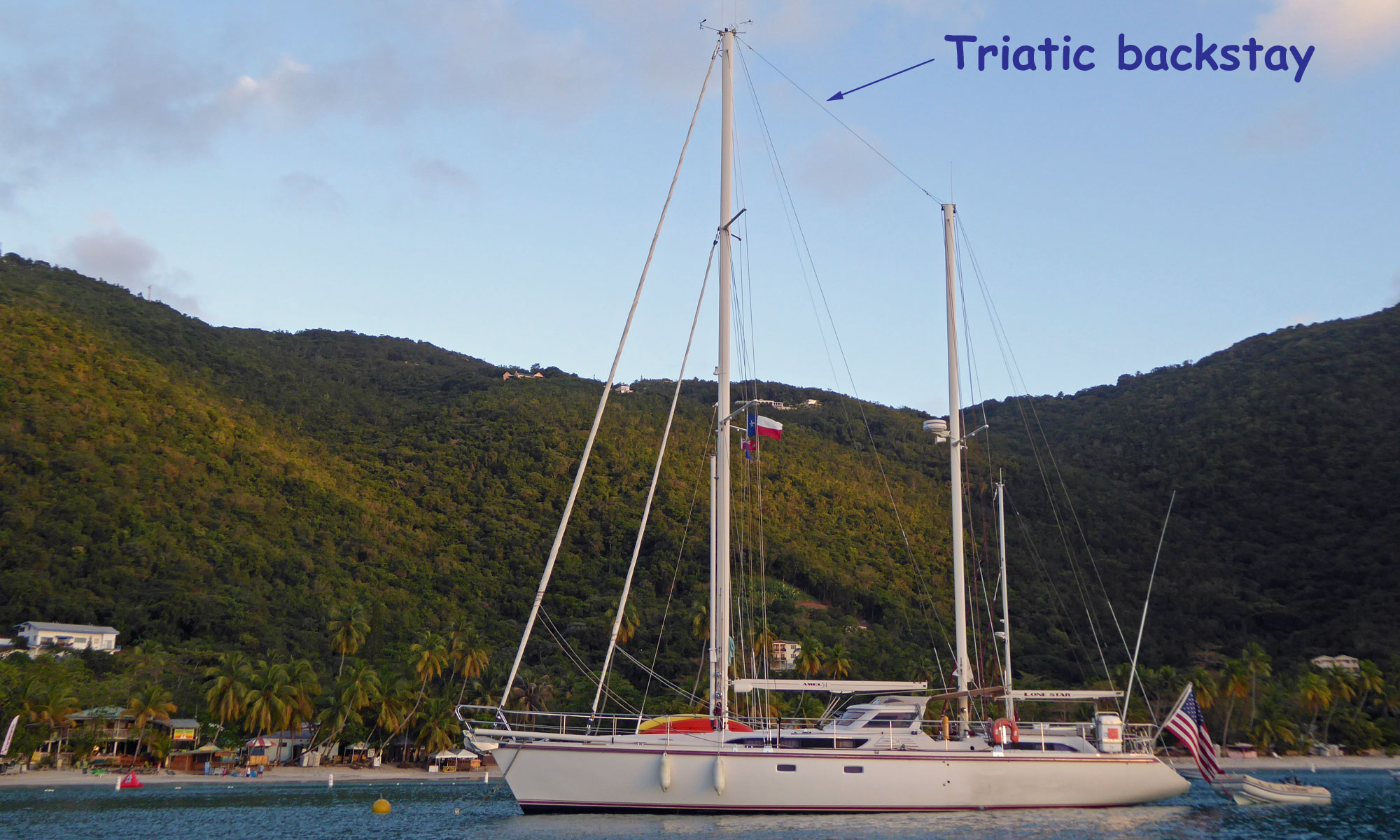- Home
- Types of Sailboats
- Ketch Sailboat Cruising
Does a Ketch Sailboat Make a Good Cruising Boat?
In a Nutshell
A ketch sailboat is an excellent choice for a cruising vessel, particularly for short-handed crews. Their key advantage lies in dividing the total sail area among multiple, smaller sails, making them significantly easier to handle in varying conditions.
This flexibility in sail combinations and the ability to reduce canvas quickly in heavy weather make them highly forgiving and practical for long-distance passages. While they may not point as high into the wind as a performance sloop, their off-wind performance and overall stability are superb, offering a comfortable and safe sailing experience.
Table of Contents
- What is the Difference Between a Ketch & a Yawl?
- How Does a Ketch’s Rig Benefit a Cruising Sailor?
- Understanding the Cutter Ketch & Mizzen Staysail
- The Performance Side of Things: Are Ketches Slow?
- What Are the Costs & Maintenance Issues for a Ketch
- Iconic Ketch Designs & Builders for Blue Water Cruising
- FAQ: Common Questions About Ketches
What is the Difference Between a Ketch & a Yawl?
It's a common point of confusion, but the distinction between a ketch and a yawl is a simple one: it's all about the location of the smaller aft mast, known as the mizzen mast, relative to the rudder post.
- Ketch: The mizzen mast is located forward of the rudder post. The mizzen sail is a crucial part of the sail plan, providing significant drive, especially off the wind.
- Yawl: The mizzen mast is located aft of the rudder post. The mizzen sail on a yawl is typically much smaller and is primarily used for balancing the helm and helping the boat track on a straight course, rather than for propulsion.
The true difference is one of purpose. The ketch’s larger mizzen is a workhorse, adding power and flexibility. The yawl’s mizzen, while useful for trim and a great riding sail at anchor, is less about propulsion.
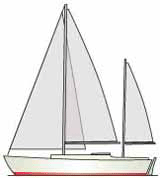 Ketch: Mizzen mast ahead of the rudder post
Ketch: Mizzen mast ahead of the rudder post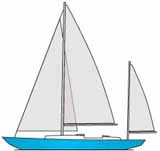 Yawl: Mizzen mast aft of the rudder post
Yawl: Mizzen mast aft of the rudder postHow Does a Ketch’s Rig Benefit a Cruising Sailor?
The ketch rig offers several key advantages that make it a favorite among cruising sailors:
- Easier Sail Handling: A ketch splits the sail area across two masts, resulting in a smaller, more manageable mainsail and a smaller mizzen. This is a game-changer for short-handed crews, as it significantly reduces the physical effort required for reefing or changing sails.
- Flexible Sail Combinations: The ketch allows for a wide array of sail combinations to suit any wind strength or point of sail. For instance, you can drop the mainsail and sail just on the jib and mizzen ("jib & jigger") in strong winds, a configuration that keeps the boat balanced and reduces stress on the rig. This is a tactic I have used numerous times in a building blow to great effect, maintaining control without having to wrestle with a full mainsail.
- Enhanced Balance & Stability: The mizzen sail acts like a weather vane, helping to balance the boat and reduce weather helm, the tendency for the boat to turn into the wind. This makes for a more comfortable ride, especially in a seaway. It also functions as an excellent riding sail at anchor, keeping the bow pointed into the wind and minimizing rolling.
Understanding the Cutter Ketch & Mizzen Staysail
To fully appreciate the versatility of a ketch rig, it's important to understand two additional sail configurations: the cutter rig and the mizzen staysail.
The Cutter Ketch (aka the Staysail Ketch): Some ketches are also rigged as cutters, meaning they have a second headsail, called a staysail, set on a stay between the mainmast and the jib. This provides even more flexibility for sail combinations. For instance, on a cutter ketch, you can sail with:
- Jib & mainsail (a standard sloop configuration)
- Staysail & mainsail (a powerful combination in heavier winds)
- Jib, staysail, mainsail & mizzen (the full suite for light air reaching)
The Mizzen Staysail: This is a light-air sail set between the top of the mizzen mast and the base of the mainmast. It's used when sailing off the wind to provide an additional boost of power. This sail is designed to catch the wind that has passed the mainsail, creating a significant increase in speed and drive on a broad reach. You will often see these sails on both ketches and yawls to improve their off-wind performance.
The Performance Side of Things: Are Ketches Slow?
While a ketch is not designed for racing around the buoys, it is by no means a slow boat. Their performance is optimized for a different purpose: comfortable, efficient long-distance cruising.
| Feature | Ketch Sailboat | Sloop Sailboat |
|---|---|---|
| Upwind Performance | Typically not as close-winded as a sloop. The mizzen can sometimes create drag. | Excels upwind due to a more streamlined rig & a single, large mainsail. |
| Downwind Performance | Superior. The mizzen adds significant drive on a broad reach or run, especially with a mizzen staysail. | Good, but requires a spinnaker or poling out the genoa for optimal performance. |
| Sail Handling | Easier for short-handed crews due to smaller, more manageable individual sails. | Requires more effort & bigger winches to handle the larger mainsail & headsail, especially in a blow. |
| Comfort at Sea | More stable & forgiving. The divided rig reduces the size of the mainsail, which in turn reduces the pitching moment. | Can be more prone to heeling & weather helm in heavy weather due to the concentration of sail area. |
| Cost & Maintenance | More expensive to build & maintain due to additional mast, rigging, & sails. | Less expensive to build & maintain due to a simpler rig. |
| Space | The mizzen mast can impact cockpit & deck layout. | More open deck & cockpit space due to a single mast. |
What Are the Costs & Maintenance Issues for a Ketch?
While the advantages of a ketch are clear, it is important to be realistic about the financial & maintenance implications. A ketch has more rigging, more sails, and a second mast, which means more to inspect, maintain, & replace.
- Initial Cost: A ketch will generally have a higher initial build or purchase cost than a comparable sloop due to the additional hardware & complexity of the rig.
- Annual Maintenance: Budgeting for ongoing maintenance is critical. The "10% rule of thumb"—that a boat will cost roughly 10% of its value to maintain annually—is a good starting point. For a ketch, with its added systems, you might find yourself at the higher end of that scale. Expect to spend more on things like replacing standing rigging, servicing winches, & repairing or replacing sails, as there are more of them.
- Triatic Stay Warning: While many ketches have a triatic backstay connecting the main & mizzen mastheads, this is a point of potential failure. As one experienced sailor wisely told me, "In the event of the loss of one mast, it's almost guaranteed to result in the loss of the other." Each mast should be independently stayed to prevent a domino effect.
Iconic Ketch Designs & Builders for Blue Water Cruising
For those considering a ketch for long-term cruising, it’s invaluable to look at the designs that have proven their mettle over thousands of ocean miles. Certain builders & designers have made the ketch their signature rig, perfecting its use for comfortable, reliable passage-making.
- Amel Ketches: The French builder Amel is synonymous with the ketch rig. Their designs, such as the famous Amel Super Maramu and the Amel 54, are celebrated for being purpose-built, "live-aboard" cruising yachts. They are known for their rugged, semi-enclosed cockpits, comprehensive systems, and single-handed sailing capabilities, making them a top choice for world cruisers.
- Nautor Swan 65: Designed by the legendary Sparkman & Stephens, the Swan 65 ketch is arguably one of the most famous sailing yachts ever built. Famed for its combination of elegant lines, exceptional build quality, and powerful performance, the Swan 65 dominated the first Whitbread Round the World Race in 1973–74, cementing its status as a timeless classic.
- Allied Princess 36: This classic American-built ketch is known for its solid construction and reputation for seaworthiness. It is a highly regarded design for its offshore capability in a more compact size.
- Hinckley Sou'wester Series: The Hinckley Company, a name known for its impeccable build quality and classic American style, produced several stunning ketch designs in its Sou'wester series. These vessels are celebrated for their graceful aesthetics & high-quality finish.
So that's the ketch, but what about other cruising rigs? For those you should take a look at our article The Ultimate Guide to Sailboats & Rigs: Sloops, Ketches & More...
Article written by Dick McClary, RYA Yachtmaster & Yachting Journalists Association (YJA) member.
FAQ: Common Questions About Ketches
Can a ketch be sailed single-handed?
Can a ketch be sailed single-handed?
Yes, absolutely. In fact, a ketch is often preferred for single-handed or short-handed sailing because the smaller sail sizes are much easier to manage alone.
What is a "staysail ketch"?
What is a "staysail ketch"?
A staysail ketch is a rig that includes an inner staysail between the mainmast and the jib. This adds another sail combination, making the rig even more flexible & powerful, especially on a reach.
Can the mizzen mast be used for anything else?
Can the mizzen mast be used for anything else?
Yes. The mizzen mast is a perfect location for mounting radar scanners, wind generators, or even lifting a dinghy aboard with a boom-mounted tackle system.
Are ketch sailboats more difficult to maintain?
Are ketch sailboats more difficult to maintain?
Yes. The ketch rig has more parts than a sloop—an extra mast, additional standing and running rigging, and more sails—which means there are more components to inspect, service, and replace over time. The trade-off is the ease of sail handling at sea.
Why have ketch sailboats fallen out of favour?
Why have ketch sailboats fallen out of favour?
The rise of modern sail-handling technology, such as efficient furling systems for larger headsails & mainsails, has made a single-masted sloop almost as easy to handle for a small crew. In addition, the lower construction & maintenance costs of a sloop have made it the more common choice in recent decades.
Sources Used
- Follow the Boat: https://followtheboat.com/ep-196/
- TripSavvy: https://www.tripsavvy.com/buying-a-sailboat-sloop-vs-ketch-2915587
- Rightboat: https://www.rightboat.com/blog/ketch-vs-yawl
- Sailing Wisdom: https://www.youtube.com/watch?v=iWysnE-_ESM
Recent Articles
-
Passoa 47 Sailboat Review: Comprehensive Specs & Performance Analysis
Jan 04, 26 04:57 AM
Discover the Passoa 47, a legendary aluminium blue water cruiser by Garcia. Explore technical specifications, design ratios, and why its lifting keel is a game-changer for offshore sailors. -
Sailboat Wheel Steering Maintenance & Inspection Checklist
Dec 30, 25 02:32 PM
Keep your vessel’s helm responsive and reliable with our expert maintenance checklist. Master cable tensioning and system inspections to avoid mid-passage failures. -
Modern Boat Electronics and the Latest Marine Instruments
Dec 20, 25 05:27 PM
Should sailboat instruments be linked to the latest boat electronics as a fully integrated system, or is it best to leave them as independent units?
